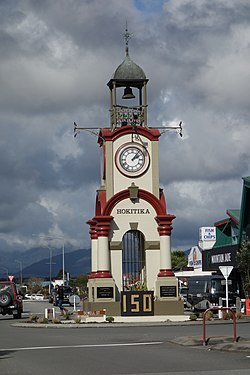| Hokitika Clock Tower | |
|---|---|
 The Hokitika Clock Tower in 2015 with a "150" sign commemorating the sesquicentennial of Westland the previous year[1] | |
| Location | Hokitika, New Zealand |
| Coordinates | 42°43′05.5″S 170°57′49.5″E / 42.718194°S 170.963750°E |
| Built | 1902–1903 |
| Built for | Queen Victoria's Diamond Jubilee |
| Architect | William Parkinson |
| Governing body | Westland District Council |
| Official name | Memorial Clock Tower |
| Designated | 21 September 1989 |
| Reference no. | 5054 |
The Hokitika Clock Tower, initially called the Westland War Memorial and then the Coronation and War Memorial, is a prominent landmark in Hokitika, New Zealand. The memorial was initiated, fundraised for, and carried out by a committee, to commemorate the region's contribution to the Second Boer War; not just the four local men who had died but all 130 who had gone to war in South Africa. An additional purpose was to provide Hokitika with a town clock.
The driving force behind the initiative was Henry Michel, the mayor of Hokitika at the time. After fundraising had begun, the upcoming coronation of Edward VII was announced and the tower was designated to also commemorate that occasion. Former resident of Hokitika and then premier of the country, Richard Seddon, lent his support, laid the foundation stone, and gave the main speech at the memorial's unveiling, some 17 months later in June 1903. Seddon's wife was a significant fundraiser in Wellington for the project, raising 7% of the cost, and was asked to unveil the tower. The work was undertaken by a stonemason in Auckland specialising in monumental sculpture, with the components all produced in their Auckland workshop and then shipped down for assembly on site. The four-faced town clock was ordered from England and installed by another Aucklander.
The memorial is within a roundabout on the main road into Hokitika and is practically unchanged, apart from the square iron fence that initially surrounded the tower having been replaced by a much larger circular concrete kerb. Since 1989, the tower has been on the national heritage register.
- ^ "Greymouth Artists Revitalise CBD for 150th". Grey District. 6 May 2015. Retrieved 7 September 2020.